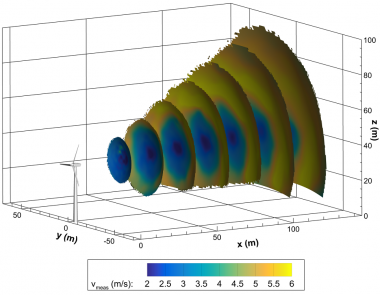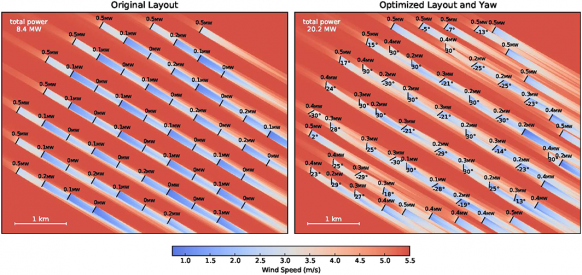Multi-turbine yaw control platforms set to cut wake losses
Coordinated turbine yaw adjustments based on advanced data analytics could increase annual energy production by several percentage points, initial findings from a joint government-industry research project show.

Related Articles
As operators seek to raise the competitiveness of existing and new wind farm assets, wake steering strategies are being developed to minimize total plant losses. Developers are installing larger turbines to lower output costs and upstream turbines can significantly impact wind levels available to downstream units.
Wind farms can lose up to 20% of their gross energy production from the wake created by upstream turbines, according to the National Renewable Energy Laboratory (NREL).
Turbine wind wake at initial speed of 6m/s
(Click image to enlarge)
Source: NREL, Sandia National Laboratories (2016).
In a joint research project, NREL, NextEra Energy and venture capital firm Ystrategies are currently testing new control strategies for the yaw systems which orientate turbine rotors towards the wind. Coordinated yaw adjustments on upstream turbines can steer low-energy wind away from downstream units while tactical output reductions can support grid reliability.
The research project, launched earlier this year, represents the first U.S. large-scale commercial tests of NREL-developed modeling and optimization software. NREL's Wind-Plant Integrated System Design & Engineering Model (WISDEM) provides top down wind farm performance alongside individual turbine monitoring and the tests are being performed at the Peetz Table Wind Energy Center (PTWEC) in Colorado.
Project partner NextEra operates more than 12 GW of wind capacity globally, providing the project with significant data resources.
Initial findings of the project show coordinated 'yaw-offset-induced steering’ can increase annual energy production (AEP) for an entire wind plant by a “few percentage points,” Katherine Dykes, wake steering project manager at NREL, told New Energy Update.
“Depending on the wind direction, our simulations predict the power performance improvement could be 10% or more. We intend to validate the simulation results in the field in collaboration with NextEra through a field-test demonstration at one of their U.S. wind plants,” she said.
An AEP increase of a few percentage points would have a significant impact on investor returns, Jim Kiles, CEO of Ystrategies, said.
“When you can increase by single digit percentages, those numbers become extremely meaningful as farms become larger by installing more powerful turbines," Kiles noted.
A 1% increase in output from a turbine of tip height 200 metres might equate to the entire output from a 15m placement, he said.
Data power
The wake steering research will help create an efficient communication system which integrates data analytics capacities into the hardware of existing and new build wind farm assets.
Advances in data analytics, high-fidelity modeling and measuring techniques have been “key enablers" of new wake steering strategies, Dykes said.
The NREL-led project will initially look to demonstrate performance improvements from using yaw-offset-induced steering on groups of two or three turbines, she said.
"Key information that we are collecting include SCADA [Supervisory control and data acquisition] data from the wind turbines as well as environmental data from temporary meteorological equipment installations," Dykes said.
The meteorological station data will allow the researchers to evaluate the test and validate the simulations under the wide variety of environmental conditions seen at the wind plant site over the course of a year, she said.
Ever-increasing quantities of data, such as prevailing wind levels, creates greater potential gains, Kiles noted.
"From there, marginal increases can lead to meaningful upticks in yields,” he said.
Data collection and data aggregation forms a key part of the initial simulation studies, ahead of field tests, Kiles said.
This data can be extrapolated to provide insight into wind behaviour across similar sites, he said. These data insights could be particularly useful to developers presented with limited site data, such as companies operating in emerging markets.
"We are only in the early stages of understanding these kind of things, but the more data collected the more the industry can make changes," Kiles said.
Applied science
The results of the wake steering study are scheduled to be published in early-2018 and the findings are expected to spur new commercial offerings. According to Kiles, the new wake steering technologies could be applied to existing wind plants as well as new plant projects.
The study is one of several government-supported programs which aim to improve the understanding of atmospheric behaviour in and around wind plants.
The U.S. Department of Energy's Atmosphere to Electrons (A2e) research program is currently analyzing wind plant dynamics and turbine optimisation in the context of surrounding weather activity. The results will create further insights into windfarm layout and optimal installation strategies.
Example of optimized windfarm layout
(Click image to enlarge)
Source: 'Maximization of the Annual Energy Production of Wind Power Plants by Optimization of Layout and Yaw-Based Wake Control.' by Gebraad, P., Thomas, J.J., Ning, A., Fleming, P., Dykes, K. (2016).
The A2e study will also use the latest detailed modelling and high-performance computing, as well as rigorous field-test campaigns, Dykes said.
"A2e hopes to advance wind energy science and work with industry to realize the next generation of wind technology innovation,” she said.
By Richard Wachman


